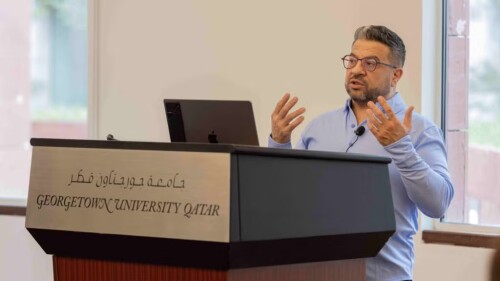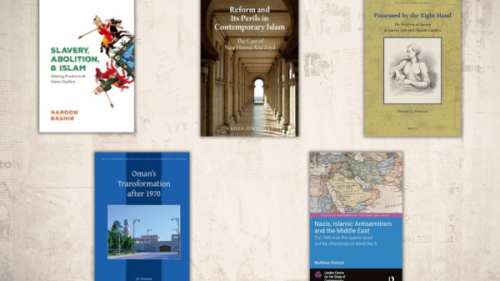Waste Siege: The Life of Infrastructure in Palestine. By Sophia Stamatopoulou-Robbins. Stanford: Stanford University Press, 2019. 344 pp. $90 ($28, paper).
Tolerance Is a Wasteland: Palestine and the Culture of Denial. By Saree Makdisi. Berkeley: University of California Press, 2022. 244 pp. $29.95.
Two recent academic books demonizing Israel illustrate how Middle East studies are being shaped (and corrupted) by obsessions.
By academic standards, Waste Siege, the Life of Infrastructure in Palestine by Sophia Stamatopoulou-Robbins, assistant professor of anthropology at Bard College, is a widely acclaimed book, winning awards from the American Ethnological Society and the American Anthropological Association in 2021, and the Middle East Studies Association (MESA) in 2020. MESA, the organization doing more than any other to corrupt Middle East studies, celebrated it as “a sophisticated theoretical analysis ... [that] focuses on the governance and governing power of waste.”
Awards notwithstanding, Waste Siege will win a microscopically narrow readership and change few minds. Though ostensibly about infrastructure in the West Bank, like most propaganda masquerading as “Palestine” studies, the book really mounts an argument about Israel as a “settler-colonial occupier.” In this instance, it supposedly engages in a “siege of waste” against the beleaguered, oppressed Palestinian people in a disgusting tour of dumps, sewers, cesspits, rubbish markets, and landfills. Somehow, the lessons from leakage, contamination, wet buckets, accumulation sites, and a host of other unpleasantries nearly always amount to an indictment of the Jewish state.
Waste Siege combines the inaccessible jargon typical of academia (“technoasethetics of a modern landfill,” “bread as infrastructure and its latent commons”) but the most memorable passages depict the gory reality of living under the tender mercies of the Palestinian Authority (as 95 percent of West Bankers do). In these areas,
Sewage mixes with groundwater, making it unsuitable for drinking. Mosquitoes feed off pools of raw excrement and proliferate. Fights break out among neighbors as one household channels its sewage too close to another.
Some irresponsible passages conflate rumor with scholarship as when the assistant professor writes that “the possibility is whispered that Israel is disposing of nuclear wastes in Shuqba,” and the Palestinian Authority reported that “Israel had buried eighty tons of nuclear waste 328 yards from Nablus, and more in Hebron.” This is gossip, not the kind of scholarship one might expect from Stanford University Press.
Rather than blame Israel for Palestinian filth, Stamatopoulou-Robbins might have explored what role decades of “resistance” and rejectionism have played. Her book steadfastly ignores the question of how billions of dollars in Western largesse were wasted on the fantasy of eradicating Israel. How many sewage treatment plants and water filtration systems could have been bought with the money actually spent on bombs and pay-to-slay? A superior researcher might have traveled to Qatar and Turkey and asked that question of Palestinian “resistance” leaders amid the comfort of their very sanitary palaces.
Where Stamatopoulou-Robbins blames Israel for the Palestinian’s waste problems, Makdisi, a professor of English and comparative literature at the University of California, Los Angeles, argues in Tolerance Is a Wasteland that everything deemed Israeli is but an illusion. On page 1, he announces that Israel is
a violent project of colonial dispossession and racial discrimination ... repackaged into ... the exact opposite: the embodiment of ecological regeneration, multicultural tolerance, and democratic idealism.
Makdisi comes from anti-Israel royalty: his mother, Jean Said Makdisi, wrote a book hostile to the Jewish state. His uncle is none other than Edward Said. Like his mother and uncle, Makdisi adopts every cliché, exclaiming that Israel is “in a clinical (not merely rhetorical) sense, an apartheid state,” deriding the rights of Israel’s lesbian-gay-bi-transgender communities as “pink-washing,” and calling Gaza an “open-air prison.”
Much of Tolerance Is a Wasteland focuses on the Simon Wiesenthal Center’s Museum of Tolerance in Jerusalem. Makdisi portrays it as built on top of a graveyard “estimated to have been established in the seventh century and to contain the remains of companions of the Prophet Muhammad as well as warriors of Salah al-Din’s (Saladin’s) army.” In his outrage, he somehow ignores the fact that the small corner of the Mamilla Cemetery covered over by the new building site had been a municipal parking lot since the 1960s.
For Makdisi,
only a profound form of denial could enable the placement of a monument to Zionism-as-tolerance on an ethnically cleansed graveyard ... “Tolerance,” it turns out—this kind of tolerance, at least—is nothing but a wasteland.
Makdisi tries to obfuscate with postmodern word-play (the prose reeks of Derida worship) with many words. For example, occlusion and its variant forms are intended to be intellectually seductive but come off as sophistry. For all the fun the author has deconstructing and reconstructing sustainability, affirmation and denial, and diversity, he should instead have examined his own assumptions about indigeneity—a term he invokes but never explores.
Both books exemplify style over substance and preconceived conclusions over evidence.
In the same way that Stamatopoulou-Robbins overlooks Palestinians as the creators of their own waste, Makdisi’s insistence that Israel is built on colonized Palestinian territory ignores that al-Aqsa Mosque was built by colonizing Muslims from Arabia who occluded the Temple Mount. Likewise, he ignores the fact that Palestinian identity is affirmed by denying Jewish identity and history in territory that was the center of the Jewish world millennia before the advent of Islam. Makdisi bemoans the removal of graves from the Mamilla Cemetery without acknowledging that they contained the remains of seventh-century Arabian and twelfth-century Egyptian colonizers of a historic Jewish territory.
In different ways, these two books exemplify the privileging of style over substance and preconceived conclusions over evidence. These tendencies are now endemic in some sectors of academia, especially in Middle East studies. The hours spent reading these books amount to wasted time.
A.J. Caschetta is a Ginsburg-Milstein fellow at the Middle East Forum and a principal lecturer at the Rochester Institute of Technology.









